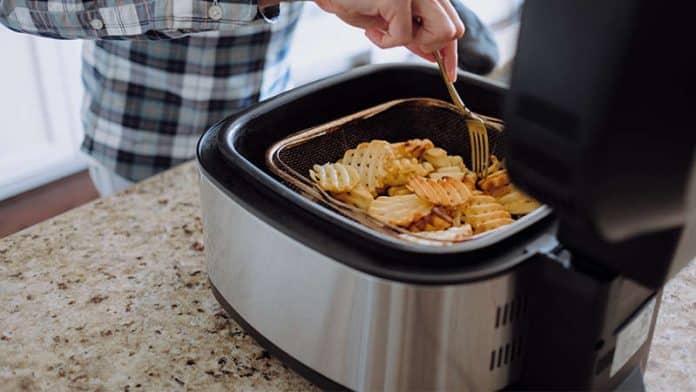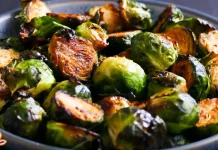Air fryers have become increasingly popular in kitchens worldwide, promising a healthier alternative to traditional frying methods.
But as with any new kitchen gadget, there are common mistakes that people often make when using air fryers. From overcrowding the basket to neglecting to preheat the appliance, these errors can lead to less–desirable results.
In this article, we will uncover some of the most frequent mistakes individuals make when using air fryers and provide simple tips to help you achieve crispy, delicious dishes every time.
Not Preheating the Air Fryer
Neglecting to preheat the air fryer
One common mistake that people often make when using air fryers is neglecting to preheat the appliance. Preheating is a crucial step in the air frying process as it helps to ensure that the food cooks evenly and achieves a crispy texture. By not preheating the air fryer, you may end up with undercooked food or lack the desired crunchiness.
The importance of preheating
Preheating the air fryer is essential because it allows the appliance to reach the optimal cooking temperature before you start adding your food. This ensures that the hot air circulates evenly around the food, leading to a more consistent and even cooking process. Additionally, preheating helps to prevent the food from sticking to the basket, as the hot air creates a barrier between the food and the surface of the air fryer.
How to properly preheat the air fryer
To preheat your air fryer properly, you should follow these simple steps. First, ensure the air fryer is plugged in, and the basket is securely in place. Next, set the desired temperature for preheating, usually around 10 minutes at 400°F (200°C). Allow the air fryer to heat up for the specified time, and you’ll know it’s ready when you hear a beep or a visual indicator showing that it’s reached the desired temperature. Once preheated, you can add your food and confidently start the cooking process.
Using Too Much or Too Little Oil
Understanding the role of oil in air frying
Oil plays a crucial role in air frying as it helps to create the crispiness and golden brown color that we often associate with fried food. It also adds flavor and moisture to the food, making it more enjoyable to eat. However, too much or too little oil can produce undesirable results.
Using excessive oil
Using excessive oil in the air fryer can lead to greasy and heavy food. It can also cause the oil to splatter, creating a mess in the air fryer basket. Additionally, using too much oil can negatively impact the texture of the food, resulting in a soggy and unappealing end product.
Using insufficient oil
On the other hand, using insufficient oil can result in food that lacks the desired crispiness and flavor. Oil helps to create a barrier between the hot air and the food, allowing it to cook evenly and develop a crispy exterior. Without enough oil, the food may not achieve the desired texture and may end up dry and unappetizing.
To strike the right balance, following the recipe or guidelines provided with your specific air fryer is essential. Most recipes recommend using a light oil coating, either by spraying or brushing it onto the food, to achieve the desired results. Experimenting with different amounts of oil can help you find the perfect balance for your taste preferences.
Overcrowding the Basket
The consequences of overcrowding
Overcrowding the air fryer basket is another common mistake that many people make. When the food is packed too tightly in the basket, the hot air cannot circulate efficiently, resulting in uneven cooking. This can lead to some portions of the food being undercooked while others are overcooked or burnt.
The correct way to load the air fryer basket
To avoid overcrowding the air fryer basket, it is essential to load it properly. Start by arranging the food in a single layer, ensuring enough space between each piece. This allows the hot air to circulate freely, promoting even cooking and ensuring that all the food is perfectly cooked.
For foods that require more space, such as chicken wings or more significant cuts of meat, cooking in multiple batches may be necessary. While it may be tempting to fit as much food as possible into the basket to save time, it is important to prioritize quality over quantity for the best results.
Utilizing the air fryer’s cooking capacity
Each air fryer has a specific cooking capacity, determining how much food it can comfortably handle. It is essential to familiarize yourself with your particular air fryer’s cooking capacity to avoid overcrowding the basket. Adhering to the recommended capacity guidelines will ensure that the food cooks evenly and to your desired level of crispiness.
Not Adjusting Cooking Times and Temperatures
Following the recommended cooking times and temperatures
One mistake that people often make when using air fryers is not adjusting the cooking times and temperatures based on the specific food being cooked. While air fryers are known for their efficiency and faster cooking times compared to traditional methods, different foods require different cooking temperatures and durations.
Following the recommended cooking times and temperatures in the recipe or guidelines is essential to achieve optimal results. These recommended settings have been tested and calibrated to ensure the food cooks thoroughly and achieve the desired texture and taste.
Factors that may affect cooking times
While following the recommended cooking times is crucial, it is essential to consider that various factors may affect the cooking time. Factors such as the size of the food, its initial temperature, and even the altitude at which the air fryer is being used can impact the cooking process.
Using these recommended cooking times as a starting point and monitoring the food closely during the cooking process is essential. Adjustments may need to be made based on visual cues, such as the color and texture of the food, to ensure that it is cooked to perfection.
The importance of monitoring food while air frying
Another mistake often made is neglecting to monitor the food while cooking in the air fryer. Unlike traditional ovens or stovetop cooking, air frying requires a more hands-on approach. While the cooking times and temperatures provide a guideline, it is essential to visually inspect the food and test its doneness before removing it from the air fryer.
During the cooking process, check on the food periodically to ensure even browning and to prevent overcooking or burning. Use the air fryer’s transparent or openable lid to assess the food’s progress visually. By actively monitoring the food, you can make any necessary adjustments to ensure it reaches the desired level of doneness.
Neglecting to Shake or Flip the Food
Why shaking or flipping food is necessary.
Shaking or flipping the food during the air frying is a crucial step that should not be overlooked. Shaking or flipping the food ensures that all sides are exposed to the hot air, resulting in even cooking and a crispy exterior. Neglecting to shake or flip the food can lead to unevenly cooked food, with one side being overcooked while the other remains undercooked.
How often do you shake or flip the food
The frequency at which you should shake or flip the food will depend on the specific recipe or food being cooked. As a general guideline, shaking or flipping the food once or twice during the cooking process is recommended. This allows the heat to be evenly distributed and ensures that all sides are exposed to the hot air.
For foods that require longer cooking times, such as chicken thighs or thicker cuts of meat, flipping them halfway through the cooking process can promote even browning and prevent excessive drying on one side.
Ensuring even cooking and crispiness
Shaking or flipping the food not only helps to ensure even cooking but also promotes the desired crispiness. Flipping or shaking allows accumulated moisture to evaporate as the hot air circulates the food, resulting in a crisper exterior. This step is crucial when air frying foods coated in breading or flour to achieve that satisfying crunch.
By incorporating the simple act of shaking or flipping into your air frying routine, you can significantly improve the overall result and enjoy evenly cooked, crispy food every time.
Not Using Parchment Paper or Non-Stick Spray
Preventing food from sticking to the basket
One of the benefits of using an air fryer is the ease of cleaning compared to traditional frying methods. However, failing to use parchment paper or non-stick spray when cooking can lead to food sticking to the basket, making the cleaning process more challenging.
Using parchment paper as a liner
Using parchment paper as a liner in the air fryer basket can help prevent food from sticking. Cut a piece of parchment paper to fit the basket and place it at the bottom before adding the food. The parchment paper acts as a barrier between the food and the basket, making it easier to remove the food once it is cooked and preventing any residue from sticking.
Applying non-stick spray to facilitate easy cleaning
Alternatively, using a non-stick cooking spray can also prevent food from sticking to the basket. Before preheating the air fryer, spray a light non-stick onto the basket. This layer of oil will help create a non-stick surface and facilitate easy removal of the food once it is cooked.
By taking these simple steps to prevent food from sticking, you can ensure that your air fryer remains easy to clean and maintain, saving you time and effort in the kitchen.
Not Cleaning the Air Fryer Properly
Cleaning the air fryer after each use
Proper cleaning of the air fryer is essential to maintain its performance and prolong its lifespan. Neglecting to clean the air fryer after each use can lead to food debris, oil, and odor buildup, affecting the taste and quality of cooked food.
After each use, make sure to unplug the air fryer and allow it to cool completely before cleaning. Remove the basket and any accessories, such as racks or trays, if applicable. Wash these components with warm, soapy water and a non-abrasive sponge or cloth, removing all residue. Rinse thoroughly and allow them to air dry before reassembling the air fryer.
Avoiding the buildup of food debris
To prevent food debris buildup, removing any excess grease or oil that may have accumulated in the bottom of the air fryer is essential. This can be done by wiping it with a damp cloth or paper towel. For tougher stains or residue, a mild dish soap can be used. Just rinse and dry the interior thoroughly to prevent any moisture from causing damage.
Regular cleaning and maintenance of your air fryer will not only ensure optimal performance but also extend its lifespan, allowing you to enjoy delicious and healthy meals for years to come.
The importance of unplugging the appliance during cleaning
When cleaning the air fryer, it is crucial to unplug it from the power source. This prevents any electrical accidents or malfunctions while handling and cleaning the appliance. Safety should always be a top priority when dealing with any electrical device, and the air fryer is no exception.
By following these cleaning guidelines and ensuring that the air fryer is unplugged during the cleaning process, you can maintain a clean and safe cooking environment while also maximizing the lifespan of your appliance.
Using the Wrong Accessories
Choosing suitable accessories for the air fryer
Using the right accessories with your air fryer can enhance your cooking experience and expand the variety of dishes you can prepare. Air fryers often come with a range of accessories, such as baking pans, grill racks, or skewers, that are specifically designed to fit and work well with the appliance.
Before purchasing additional accessories, ensuring they are compatible with your specific air fryer model is essential. Check the manufacturer’s guidelines or consult the user manual for recommendations on suitable accessories that can be used safely with your air fryer.
Avoiding unsafe or incompatible accessories
Using unsafe or incompatible accessories can lead to accidents or damage to the air fryer. For example, using metal utensils or accessories with a non-stick coating can scratch or damage the non-stick surface of the air fryer basket. Additionally, using accessories that are too large or obstruct hot air flow can disrupt the cooking process and lead to unevenly cooked food.
To avoid mishaps, it is best to stick to the accessories provided by the manufacturer or those recommended as compatible with your specific air fryer model. This ensures that the accessories are designed to fit correctly and work seamlessly with the appliance, promoting safe and efficient cooking.
Enhancing the air frying experience with appropriate tools
Using the right accessories can elevate your air frying experience and open up a world of culinary possibilities. Baking pans or molds can create pizzas, cakes, or casseroles in your air fryer, while grill racks or skewers can help you achieve that perfect sear on your meat or vegetables. By exploring and utilizing the appropriate tools, you can unleash your creativity in the kitchen and experiment with a wide range of delicious dishes.
Not Preparing Frozen Foods Properly
I am correctly thawing frozen foods before air frying.
Air fryers are often praised for their ability to quickly cook frozen foods, eliminating the need for lengthy thawing times. However, it is essential to properly thaw certain frozen foods before air frying to ensure food safety and optimal cooking results.
Foods such as meat or seafood should be entirely thawed before air frying to ensure they cook evenly and at a safe temperature. Thawing can be done by transferring the frozen food to the refrigerator and allowing it to thaw overnight. Alternatively, you can use the defrost function of your microwave if you need to thaw the food quickly.
Adjusting cooking times and temperatures for frozen foods
When cooking frozen foods in the air fryer, it is essential to adjust the cooking times and temperatures to compensate for the lower starting temperature of the food. Frozen foods will generally require slightly longer cooking times and slightly higher temperatures compared to their fresh counterparts.
Start by preheating the air fryer for a few minutes longer than usual to ensure that it reaches the desired temperature. Then, follow the recommended cooking times and temperatures provided in the recipe or guidelines for cooking frozen foods. Keep an eye on the food during the cooking process and adjust the cooking time if needed to ensure that it is thoroughly cooked and reaches a safe internal temperature.
Avoiding safety hazards when cooking frozen foods
Cooking frozen foods in the air fryer can present some safety hazards if not done correctly. It is important to remember that frozen foods may contain ice crystals or excess moisture, which can cause splattering or steaming when placed in the hot air fryer. Always use oven mitts or heat-resistant gloves when handling the air fryer basket or removing the food from the appliance to minimize the risk of burns.
By properly thawing frozen foods, adjusting the cooking times and temperatures, and practicing safe handling techniques, you can enjoy delicious and safely cooked meals using your air fryer.
Expecting the Same Results as Deep Frying
Understanding the differences between air frying and deep frying
Air and deep frying are two distinct cooking methods that yield different results. While deep frying involves immersing food in hot oil, air frying relies on circulating hot air to cook the food. It is essential to understand these differences to avoid unrealistic expectations when using an air fryer.
Air frying generally produces food with a crispy exterior and a moist interior, with less grease and fat than deep-fried food. While air frying can yield deliciously crispy results, it may not replicate the exact texture and taste of deep-fried food.
Managing expectations regarding texture and taste
Managing your expectations regarding the texture and taste of air-fried food is crucial to fully appreciate the benefits of this cooking method. Air-fried food may have a lighter and less oily mouthfeel than deep-fried food. While the crispiness can be achieved, it may not be as pronounced or have the same deep golden color as deep-fried food.
However, air frying offers the advantage of healthier cooking with reduced fat and calorie content. By focusing on the unique qualities and benefits of air-fried food, you can truly embrace this cooking method and enjoy various dishes with guilt-free indulgence.
Embracing the health benefits of air frying
One of the most significant advantages of air frying is its ability to cook food with significantly less oil than deep frying. Air fryers use hot air circulation to cook food, resulting in a crispy texture without the need for excessive oil. By embracing the health benefits of air frying, you can enjoy your favorite fried foods with reduced fat and caloric intake.
Air frying also minimizes the production of harmful substances, such as acrylamide, formed when starchy foods are cooked at high temperatures. This makes air frying a healthier alternative to traditional deep frying methods.
By adjusting your expectations and focusing on the health benefits of air frying, you can fully embrace this cooking technique and explore a range of delicious and guilt-free dishes.
In conclusion, using an air fryer can revolutionize your cooking experience by providing a healthier alternative to traditional frying methods. However, it is essential to avoid common mistakes to achieve the best results.
By preheating the air fryer, using the right amount of oil, avoiding overcrowding the basket, adjusting cooking times and temperatures, shaking or flipping the food, using parchment paper or non-stick spray, cleaning the air fryer properly, using the right accessories, preparing frozen foods properly, and managing your expectations, you can ensure that your air frying endeavors are successful and enjoyable.
So go ahead, grab your air fryer, and embark on a culinary journey that showcases the magic of hot air and healthy cooking. Happy air frying!































